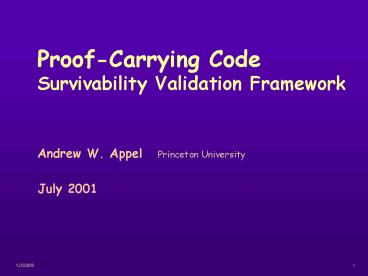ProofCarrying Code Survivability Validation Framework PowerPoint PPT Presentation
1 / 19
Title: ProofCarrying Code Survivability Validation Framework
1
Proof-Carrying CodeSurvivability Validation
Framework
- Andrew W. Appel Princeton University
- July 2001
2
1. Security problems addressed
- Distributed authorization
- Public key distribution
- Certificate authorities
- Code signing
- Component-linking policies
- Access control
- Solution Proof-carrying authentication/authoriza
tion
- Building systems with mix of trusted and
untrusted components - COTS
- Applets, servlets
- E-mail attachments
- Want rich, object-oriented APIs between
components - No virtual-memory context switch, please
- Solution Proof-carrying code
3
Protection problem
not trusted
System Resources
Access to system resources mediated by API
Application Program
API
Privilege Checking, Mediation, Capability
management
Must prevent capability-management from being
bypassed
4
Technology description Proof-carrying code
Code Producer
Code Consumer
Native Code
Source Program
Compiler
Execute
load r3, 4(r2) add r2,r4,r1 store 1, 0(r7) store
r1, 4(r7) add r7,0,r3 add r7,8,r7 beq r3, .-20
Policy
Policy
Safety Theorem
Safety Theorem
Safety Proof
Prover
-i( ?-i(... ?-r ( ...) ) )
OK
Checker
5
2. Assumptions
- A1 Hardware (instruction-set architecture)
operates correctly - No uncorrected bit-errors, no attacks by voltage
variation, - A2 Hosts access control policy is appropriate
- Written by host administrator
- Uses our policy language
6
3. Threats, Attacks, Vulnerabilities
- Design
- TAV-1.1 Exploitable inconsistency in policy
- TAV-1.2 Erroneous decision procedure for
granting access - Implementation
- TAV-2.1 Bug in implementation of protection
mechanism - TAV-2.2 Bug in implementation of decision
procedure - Operation
- TAV-3.1 Client code fetches/stores
out-of-bounds address - TAV-3.2 Client code jumps to out-of-bounds
address - TAV-3.3 Inconsistency in link-loading name
resolution - TAV-3.4 Client code doesnt execute whats
checked - TAV-3.5 Forging of certificates
- TAV-3.6 Attackers uses compromised keys
7
4. Survivability Security Goals
- AV Availability not addressed
- I Integrity
- Low-level addressed by Proof-carrying code
- High-level addressed by Proof-carrying
authorization - C Confidentiality
- Low-level addressed by Proof-carrying code
- High-level addressed by Proof-carrying
authorization - AU Authentication
- Addressed by proof-carrying authorization
- NR Nonrepudiation not addressed
- F Flexibility
- Flexible and expressive design of APIs and
policies
8
5. Comparison with other systems
Operating system, virtual memory
System Resources
Virtual memory
Application Program
Privilege Checking, Mediation, Capability
management
API
9
Threat matrix
- Operating System with Virtual Memory
Design
Impl.
Operation
10
Java Virtual Machine
System Resources
Application Program
API
Privilege Checking, Mediation, Capability
management
Application Program
Run time
Link time
11
Threat matrix
- Java Virtual Machine
Design
Impl.
Operation
12
Code signing
I promise not to bypass APIs
System Resources
Application Program
API
Privilege Checking, Mediation, Capability
management
Signed, Microsoft
13
Threat matrix
- Code signing (ActiveX)
Design
Impl.
Operation
14
Our solution
- Proof-carrying code, proof-carrying authentication
Design
Impl.
Operation
15
6. Mechanisms
- M1 Prover constructs safety proof for
untrusted application binary - M2 Machine specification axiomatizes
instruction-set architecture - M3 Safety policy defines theorem to be
proved - M4 Proof checker determines whether proof
matches theorem - M5 Policy modeler validation technique for
safety policies - M6 Semantics of types used in constructing
safety proofs - M7 Digital signatures can be generated only by
holder of private key - M8 Expiration freshness dating certificates
limits harm from key loss
16
Rationale
- Proof-carrying code, proof-carrying authentication
17
Trusted Computing Base
Foundational Proof-Carrying Code
18
8. Residual risks, limitations, caveats
- Might not scale to full-featured source languages
- Prover or checker might be too slow
- Compiler/prover technology might be too complex
for development outside academia - Covert channels
- Measurements of TCB dont include C compiler that
compiles the checker
19
9. Costs
- Execution speed
- Interface-crossing performance excellent
- Intramodule execution very good
- Binary size
- Executable binaries larger (factor of two?)
- No cost to in-core footprint during execution
- Loading, linking time (proof check required)
- Software development
- Must use type-safe source language such as Java
- COTS software in Java OK
- COTS software in C, C not OK
- Technology development
- Competitive technologies (virtual memory, JVM, )
established and well understood

